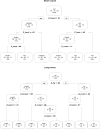Contributions of each of the four swimming strokes to elite 200-400 individual medley swimming performance in short and long course competitions
- PMID: 38111656
- PMCID: PMC10726738
- DOI: 10.7717/peerj.16612
Contributions of each of the four swimming strokes to elite 200-400 individual medley swimming performance in short and long course competitions
Abstract
Objectives: The relative contribution of each of the four strokes to performance, and whether these contributions differ substantially between short course and long course competitions is unclear. To clarify these issues the aim of this study was to assess the strokes that have more influence on the performance in the 200 and 400 m IM swimming performances of elite male and female swimmers, participating in major events: Olympic Games (OG) and World Championship (WC) in short-course and long-course from 2012 to 2021.
Methods: Data from 1,095 swimmers (501 women and 594 men) who competed in 200 and 400-m IM were obtained with a minimum level of 800 FINA points. Linear regression modelling and classification trees were employed to quantify differences between strokes and short/long course swimming.
Results: Regression analysis indicated that breaststroke (β = - 0.191; p < 0.000) and backstroke (β = - 0.185; p < 0.000) had a bigger effect on IM performance, with butterfly (β = - 0.101; p < 0.000) having a lesser impact. The classification trees showed threshold performance standards in terms of 50-m times in form-stroke events must be fulfilled to attain medal-winning performances.
Conclusions: These form-stroke standards represent important milestones for designing medal-oriented training strategies for both 200 IM and 400 m IM. Achieving a medallist position in 200 and 400 m IM requires obtaining specified lap times in butterfly, breaststroke and backstroke for males and females in long-course competitions, and breaststroke and backstroke for short-course competitions. The OG presents more exigent demands of lap times in butterfly, crawl and backstroke for IM swimmers.
Keywords: Competitions; Data analysis; Mentoring; Performance; Swimming; Tactics.
©2023 González-Ravé et al.
Conflict of interest statement
The authors declare there are no competing interests.
Figures


References
MeSH terms
LinkOut - more resources
Full Text Sources
Research Materials
Miscellaneous

